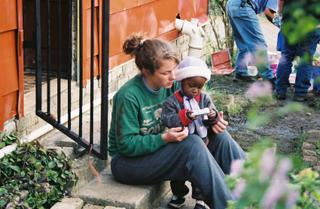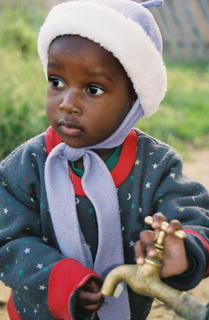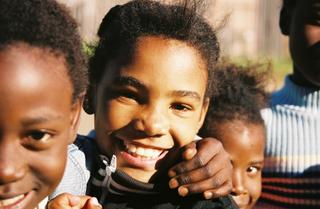
In this photograph Liza (18-year-old Belmont youth) is showing 2-year-old Nestashine a photograph on the digital camera. The children we got to know all loved the digital cameras. They were terribly disappointed when I pulled out my Nikon SLR manual camera with the 35mm film. I'm sure they were thinking: "What kind of American are you? It's 2005 and every American owns a digital camera!" I think I became acceptable again, though, when I used the Polaroid camera and let them keep the photographs.
Anyway, we met Nestashine when we worked to paint a creche (preschool) in the Khayeletu township in Knysna, South Africa. Her father Innocent is a sculptor who sometimes gets work with a painting business if they need a paint job done on a building. Since we were painting the creche, Innocent became our friend, helping us get the work done the entire two days.
So we spent only two days with Innocent, his wife Linah and his daughter Nestashine, but we tried our best to get to know them. They moved to South Africa fleeing Harare, Zimbabwe. He talked about how dangerous it was there sometimes with the government just coming in and threatening families, knocking down homes, harassing entire communities. He's not making much money, but he's working hard. So he's found his peace in South Africa but almost got an opportunity to come to the USA for work. He's still praying for that opportunity.
I met a number of refugees into South Africa. Since South Africa's freedom and new government in 1994, people from war-torn countries on the continent of Africa have fled to the Republic of South Africa. I met Germain early in our trip when we visited a restaurant in Cape Town where he worked as security. Germain is from the Democratic Republic of the Congo, and we talked for a while as I waited for the rest of the group to meet me at the restaurant. Our conversation covered many different topics from what his neighborhood was like to why our group was in South Africa. He let me practice my French. We talked about churches.
When I finally asked about the tension in the Congo, he said that rebel fighting in parts of Rwanda, Burundi and the DRC had gotten so bad it was terrifying. I asked if he had family there still or if they came with him to South Africa. He then told me that his family--wife and two tiny girls--were killed by rebel forces. After their deaths, he became a refugee in SA. He has a university degree he acquired in the DRC but can now get only this job to start his new life. But he says that God is blessing him. And he sends money home to his mother (who was too old and ill to flee with him) whenever he can.
On another note . . . A few days after meeting Innocent and family, we met their neighbor Robert at a marketplace selling his things. He shares an HIV infection with his baby boy Joseph. He was thrilled to finally meet the people from the UM Church that he'd heard Innocent talk about. Why? Because he wanted to know if we'd pray for his family: wife Elizabeth (not HIV+) and child Joseph. I hope you'll join me in prayer, too.

